Elephant Anatomy and Physiology
Written by Tina Dow for the Elephant Husbandry Resource Guide (2010)
Elephants have a monogastric digestive tract similar to a horse. Only 44% of what they eat is successfully digested, with nutrients being absorbed in a portion of their large intestine called the cecum. Because of their inefficient digestive tract, the elephant has been observed eating approximately 16 hours a day, leaving only 8 hours for socializing and sleeping. African elephants are thought to be more of a browsing species feeding on grasses, shrubs, trees, and herbs; with some large bulls capable of ingesting 400 lbs of vegetation daily. Elephants are known to travel great distances to ensure vitamin and mineral balance into their diet via consumption of soil and salt licks in caves. Comparably, the Asian elephants have a similar daily dietary requirement; however the Asian species is more of a grazer than browser. The majority of the diet, 85%, of the Asian elephant consists of grasses, bamboo, tree leaves, and fruits. Diet variation happens constantly and is dependant not only on location, but on environmental conditions and available resources as well (Dierenfeld, 2006).
absorbed in a portion of their large intestine called the cecum. Because of their inefficient digestive tract, the elephant has been observed eating approximately 16 hours a day, leaving only 8 hours for socializing and sleeping. African elephants are thought to be more of a browsing species feeding on grasses, shrubs, trees, and herbs; with some large bulls capable of ingesting 400 lbs of vegetation daily. Elephants are known to travel great distances to ensure vitamin and mineral balance into their diet via consumption of soil and salt licks in caves. Comparably, the Asian elephants have a similar daily dietary requirement; however the Asian species is more of a grazer than browser. The majority of the diet, 85%, of the Asian elephant consists of grasses, bamboo, tree leaves, and fruits. Diet variation happens constantly and is dependant not only on location, but on environmental conditions and available resources as well (Dierenfeld, 2006).
Elephants in the wild are a very long lived species and have been documented to live upwards of 65 years (Laws, 1966). The only natural limiting factor to elephant longevity seems to be the wearing down of their last set of teeth (Shoshani and Tassy, 1996). Certainly extreme environmental conditions like drought can speed up the onset of death in specific individuals. Elephants are susceptible to diseases such as anthrax, tuberculosis, and foot and mouth. Moreover, much like seen in older human beings, older elephants experience their fair share of cardiovascular disease as well as heart attacks and stroke (Fowler, 2006).
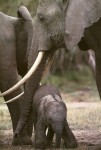 The overall anatomy and physiology of the elephant is extremely unique. Elephants, like the primate, have their mammary glands located between their front legs. Both male and female elephants have a urogenital opening that is situated between the rear legs. This unique feature paired with the fact that the male elephant has internalized testicles makes it very hard for the untrained eye to distinguish male from female (Laws, 1969). The closest known relatives of the elephant are the manatees and dugongs, hyraxes, and aardvarks; they share many anatomical commonalities (Shoshani and Tassy, 1996). However, one thing the all these related individuals do tells us about the elephant in deed is how little we know and how much we have yet to learn.
The overall anatomy and physiology of the elephant is extremely unique. Elephants, like the primate, have their mammary glands located between their front legs. Both male and female elephants have a urogenital opening that is situated between the rear legs. This unique feature paired with the fact that the male elephant has internalized testicles makes it very hard for the untrained eye to distinguish male from female (Laws, 1969). The closest known relatives of the elephant are the manatees and dugongs, hyraxes, and aardvarks; they share many anatomical commonalities (Shoshani and Tassy, 1996). However, one thing the all these related individuals do tells us about the elephant in deed is how little we know and how much we have yet to learn.
The elephant is an intelligent animal that is capable of self recognition as well as advanced problem solving skills. The brain of the adult elephant weighs more than any other land mammal, weighing approximately 4 to 6 kg. Although the brain is quite large in size, when compared to the rest of the elephants massive body we see that their brain contributes to only 0.1% of its entire body mass; the human brain is 2 % of the total body weight. At the front of the elephant brain there are very large temporal lobes which are known to function as a memory center. This is probably where the saying that an elephant never forgets originated from. Elephant calves have a brain that is only 35% of the size of an adult; this is comparable to the human newborn brain that is 25% the size of a fully grown adult. Young elephants have a lot to learn in the prepubescent years so it stands to reason that as they develop and grow bigger, so too does their brains (Schulte, 2006, Shoshani et al., 2006).
The large brick-like molars, located in the top and bottom jaws on both the left and right sides, are replaced six times during a lifetime. Molars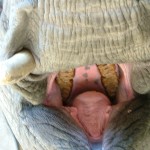 form at the rear of the jaw and moves forward and upward slowly throughout the years. This mechanism allows for the immediately replacement of a molar when the preceding tooth has become worn down. Like that which is observed in a variety of different species, in the elephant the replacement of the molars are a direct link to the age of an individual. The sixth and last set of molars began to emerge when the animal is approximately 30 years of age. When the last molar set has worn down, this happens once an individual is well into their late 50’s to early 60’s, an elephant is unable to chew its food properly. What little food that is able to be swallowed cannot be digested efficiently, at which time body condition begins to decrease rapidly and the elephant succumbs to starvation (Dumonceaux, 2006).
form at the rear of the jaw and moves forward and upward slowly throughout the years. This mechanism allows for the immediately replacement of a molar when the preceding tooth has become worn down. Like that which is observed in a variety of different species, in the elephant the replacement of the molars are a direct link to the age of an individual. The sixth and last set of molars began to emerge when the animal is approximately 30 years of age. When the last molar set has worn down, this happens once an individual is well into their late 50’s to early 60’s, an elephant is unable to chew its food properly. What little food that is able to be swallowed cannot be digested efficiently, at which time body condition begins to decrease rapidly and the elephant succumbs to starvation (Dumonceaux, 2006).
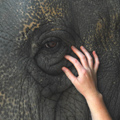 The eye of the elephant is comparable in size to that of the human being. Overall, elephants are thought to have poor eyesight; only capable of seeing clearly for short distances of 30 feet and better in dim light than bright sunlight. The elephant’s eye is protected by extremely long eyelashes which aid to protect against dirt particles and insects. A unique feature about the eye of the elephant is that there are no tear ducts present. Fluid or tears from this vestigial tear gland bathe the eye keeping it clean and moist. Excess tears either evaporate in the false duct or run down the cheek (Suedmeyer, 2006).
The eye of the elephant is comparable in size to that of the human being. Overall, elephants are thought to have poor eyesight; only capable of seeing clearly for short distances of 30 feet and better in dim light than bright sunlight. The elephant’s eye is protected by extremely long eyelashes which aid to protect against dirt particles and insects. A unique feature about the eye of the elephant is that there are no tear ducts present. Fluid or tears from this vestigial tear gland bathe the eye keeping it clean and moist. Excess tears either evaporate in the false duct or run down the cheek (Suedmeyer, 2006).
The ears serve multiple purposes that are each extremely important for the wellbeing of a given individual. First and foremost the ear is used for communication either via listening for infrasonic vocalizations (a range of 1-20,000Hz) that can be heard up to 5 km or by posturing to let others see visual behavior displays (Payne et al., 1986; Poole et al., 1988). Additionally, the elephant ear is the major regulatory component of body temperature. The ear contains a number of large blood vessels and veins that are covered by very thin and sensitive skin. A total of 12 liters of blood can flow through the vasculature of the ear every minute. As the ear is moved from front to back, air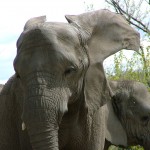 flows across the ear cooling the blood that is in the ear causing the body temperature to decrease (Mikota, 2006b). Throughout an elephants life distinctive tears and nicks will form on the outer edge of the ear. Field researchers are able to utilize these small imperfections that are specific to an individual animal for identification purposes (Douglas-Hamilton, 1972).
flows across the ear cooling the blood that is in the ear causing the body temperature to decrease (Mikota, 2006b). Throughout an elephants life distinctive tears and nicks will form on the outer edge of the ear. Field researchers are able to utilize these small imperfections that are specific to an individual animal for identification purposes (Douglas-Hamilton, 1972).
The trunk is perhaps the most versatile and important appendage on the elephant’s large body. Created via the fusion of the upper lip and nose, the elephant’s trunk consists of over 40,000 muscles. The prehensile tip(s), or finger-like projections, at the end of the trunk, one or two depending on the species, is capable of picking up a single blade of grass, but strong enough to carry trees that weigh close to one ton or 2,000 lbs. The elephant’s trunk is used to breathe, smell pheromones carried over several kilometers, vocalize via trumpets and squeaks, and, like the ears, is used in a variety of behavioral displays. The elephant is able to draw dust and mud into its sensitive trunk to be blown over the entirety of its body for parasite control in addition to sun screen. The trunk is used for drinking by drawing up to 14 liters of water up at a time to be deposited into the back of their mouth. Food items such as grasses, fruits, leaves, and branches are grabbed by trunk tips and torn into smaller portions to be placed into 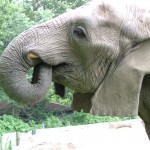 the mouth to be chewed (Isaza, 2006). A newly emerging disease called Limp Trunk Syndrome (LTS), also called Flacid Trunk Paralysis (FTP), has been recently identified in wild populations, as well as a few captive individuals. Animals afflicted with this condition experiences almost complete paralysis of the trunk, thus making it nearly impossible to eat, drink, or even breathe properly. The prognosis for wild elephants with LTS is poor. However identified captive individuals can be cared for accordingly, although quality of life is severely compromised (Kock, 1999). To date the mitigating factors and treatment of LTS remains unknown.
the mouth to be chewed (Isaza, 2006). A newly emerging disease called Limp Trunk Syndrome (LTS), also called Flacid Trunk Paralysis (FTP), has been recently identified in wild populations, as well as a few captive individuals. Animals afflicted with this condition experiences almost complete paralysis of the trunk, thus making it nearly impossible to eat, drink, or even breathe properly. The prognosis for wild elephants with LTS is poor. However identified captive individuals can be cared for accordingly, although quality of life is severely compromised (Kock, 1999). To date the mitigating factors and treatment of LTS remains unknown.
The tusks of the African elephant occur in both males and females, whereas in the Asian species only the males are endowed. However, there is documentation in a few African herds where a genetic mutation causes elephants to be tuskless. Tusks are quite simply an upper incisor that is elongated and grows continuously. Growing at a rate of up to 18 cm or 7 inches annually, it is not uncommon for mature bulls to have tusks that reach 3 meters in length and weigh over 90 kg or 200 lbs. Tusks are similar in composition to human teeth, consisting of a central core of pulp that is covered in dentine and surrounded by bone-like enamel. Approximately 95% of the tusk consists of an internal dentine; a substance more commonly referred to as “ivory” and continues to be one of the most prized illegal wildlife products in the world. Elephants of all species are hunted to near extinction for ivory which is used in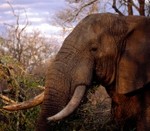 Ancient Chinese Medicine and for the making of ornamental items such as jewelry, figurines, knife handles, and such. Although a ban on ivory by the Convention on International Trade in Endangered Species of Wild Fauna and Flora (CITES) organization in 1989 alleviated the poaching epidemic that was surely on its way to eradicate the world of these magnificent creatures that same ban has been recently lifted in a few African countries to allow for the one of sale of stock piled ivory. To date there are some concern that poaching once again is on the rise, with ivory related elephant deaths at their highest in Kenya since 1990’s. Some researchers and conversationalists think that the one-off say of ivory has contributed to the stimulation of the ivory black market once again, but only time will tell if this hypothesis proves correct (CITES, 1989; Sukumar, 2003; Douglas-Hamilton, 2009).
Ancient Chinese Medicine and for the making of ornamental items such as jewelry, figurines, knife handles, and such. Although a ban on ivory by the Convention on International Trade in Endangered Species of Wild Fauna and Flora (CITES) organization in 1989 alleviated the poaching epidemic that was surely on its way to eradicate the world of these magnificent creatures that same ban has been recently lifted in a few African countries to allow for the one of sale of stock piled ivory. To date there are some concern that poaching once again is on the rise, with ivory related elephant deaths at their highest in Kenya since 1990’s. Some researchers and conversationalists think that the one-off say of ivory has contributed to the stimulation of the ivory black market once again, but only time will tell if this hypothesis proves correct (CITES, 1989; Sukumar, 2003; Douglas-Hamilton, 2009).
The elephant has many uses for their tusks which include sparing and territorial/mating disputes between males, to dig for water, minerals and roots, tree debarking, as well as moving trees to clear paths (Sukumar, 2003). Among researchers, tusk shape along with ear imperfections are used to identify individual animals (Douglas-Hamilton, 1972). However, unlike the ear tusks are broken and wore down due to fighting or extensive use. Regardless if a tusk is broken, the shape of the tusk will remain, i.e., if an elephant has one tusk that grows straighter then the other it will grow that way throughout its life. This difference in tusk shape is a good tool to distinguish between the two African elephant species, L. africana and L. cyclotis. The tusk of the forest elephant is thinner and grows at a straighter and downward angle when compared to the savannah elephant whose large tusks typically in a curved, more upward pointed orientation (Grubb et al., 2000).
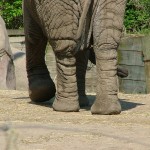 In order to support its massive body, an elephant has legs that are reminiscent of giant pillars; very dense leg bones that sit completely straight one on top of another. Because their legs have to support such weight, the elephant leg has less muscle, thus it is unable to jump or canter. However, they are capable of a fast gate called an amble which allows elephants to move very quickly when need be, reaching speeds of 25 to 35 km/hr. The amble is a movement where the animal moves both the front and rear legs on one side at the same time then switches to the other side. When walking and foraging the elephant usually moves at a rate of 6-8 km/hr (Shindo and Mori, 1965; Luikart, 2000).
In order to support its massive body, an elephant has legs that are reminiscent of giant pillars; very dense leg bones that sit completely straight one on top of another. Because their legs have to support such weight, the elephant leg has less muscle, thus it is unable to jump or canter. However, they are capable of a fast gate called an amble which allows elephants to move very quickly when need be, reaching speeds of 25 to 35 km/hr. The amble is a movement where the animal moves both the front and rear legs on one side at the same time then switches to the other side. When walking and foraging the elephant usually moves at a rate of 6-8 km/hr (Shindo and Mori, 1965; Luikart, 2000).
At the bottom of each leg is a large, round foot. The foot circumference is directly proportional to the length of the leg. The feet of elephants are very well padded because incredibly they actually stand and walk on the tips of their toes. Supporting the toes is a tough, gelatinous material that acts as a shock absorber and cushion. It is also because of this cushion that elephants are able to stand for long periods of time without pain. As previously mentioned, the number of toenails, as well as the way in which they grow, are species specific. The Asian elephant typically has five toenails on each of the front feet and four on each of the rear feet which grow in an outward motion. In contrast, the African elephant usually has four toenails on each of the front feet and three to four on each hind foot that grow from the cuticle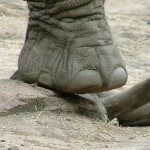 downward to the bottom of the foot. On the bottom of the elephant’s foot is a very tough, leather-like pad that grows continuously and is worn down by their natural movement (Csuti et al., 2001).
downward to the bottom of the foot. On the bottom of the elephant’s foot is a very tough, leather-like pad that grows continuously and is worn down by their natural movement (Csuti et al., 2001).
Although the skin of the elephant can be up to one inch thick in certain areas of the body, it is still an extremely sensitive organ (Horstmann, 1966). Elephants are very susceptible to sunburn, dry skin, and insect stings so it is an important part of their daily maintenance to cover themselves in mud Mikota, 2006b). Wallowing in mud allows the elephant to protect their sensitive skin and also facilitates socialization amongst herd members as well as individuals in neighboring family groups. After their mud bath the elephant will cover their wet body with another layer of dust for additional protection. An elephant’s skin color is directly dependent on the type of minerals found in their 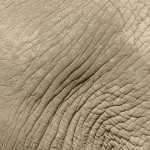 mudding areas; although their gray skin color does not change the mud covering them can be a light brown to orange-red to black. During drought not only is vegetation and water sparse for nutrition and hydration, so too is mud, thus during times when resources are not readily available, the elephant suffers immensely (Buss, 1961; Moss, 1988).
mudding areas; although their gray skin color does not change the mud covering them can be a light brown to orange-red to black. During drought not only is vegetation and water sparse for nutrition and hydration, so too is mud, thus during times when resources are not readily available, the elephant suffers immensely (Buss, 1961; Moss, 1988).